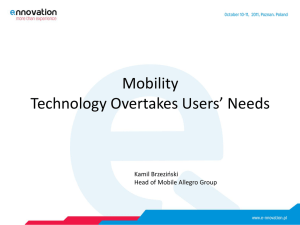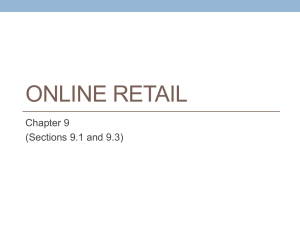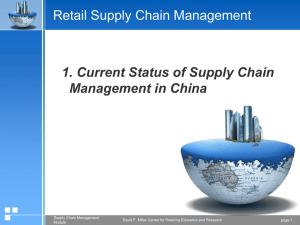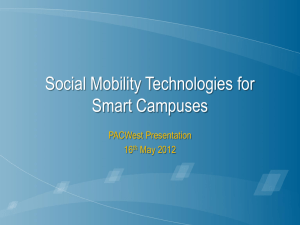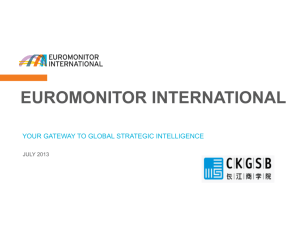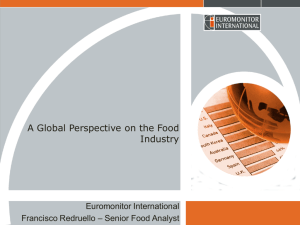Technology and retailing
advertisement
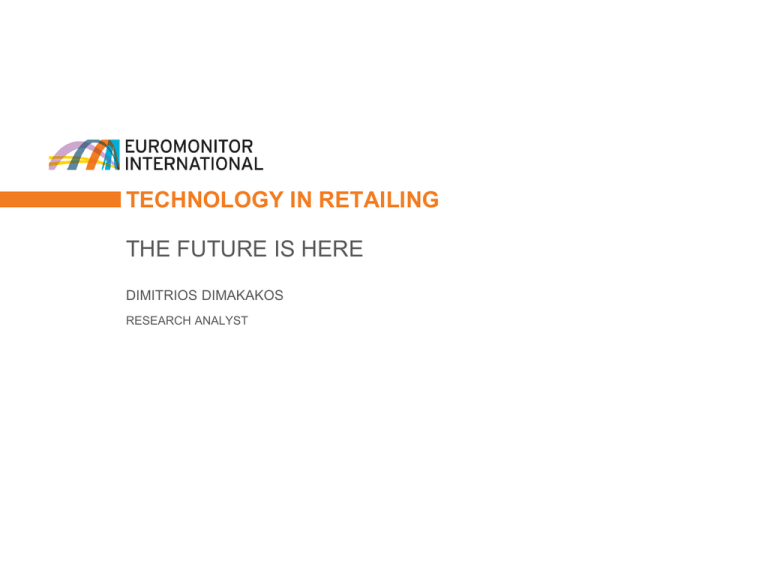
TECHNOLOGY IN RETAILING THE FUTURE IS HERE DIMITRIOS DIMAKAKOS RESEARCH ANALYST About Euromonitor International A trusted business intelligence source Biggest global player in strategic business intelligence Four decades of research experience Very widely respected across each industry covered Consumer-focused: industries, countries, consumers Subscription services and custom research 800 analysts in 80 countries Regional research hubs London (HQ), Chicago, Singapore, Shanghai, Vilnius, Dubai, Cape Town, Santiago, Sydney, Tokyo, Bangalore Industry specialist client support teams INTERNET RETAILING GROWTH TRENDS AND ANALYSIS THE FUTURE OF PAYMENTS 4 TECHNOLOGY IN RETAILING Internet Retailing Blazes a Trail 2010/2011 – Retailing – Fastest Growing Channels by Market Euromonitor International Retail sales in Japan and Western Europe, both facing rapidly ageing consumer bases, will remain relatively flat, although non-store retailing, driven by internet retailing, will continue to be a source of growth in these markets Internet retailing, however, is not necessarily the fastest growing channel in all markets. Broadband penetration and low levels of credit card ownership have hindered growth of the internet retailing channel in many emerging markets. In addition, new modern grocery formats such as hypermarkets and discounters, introduced by major international grocery retailers, have kickstarted rapid growth in Latin America and Eastern Europe. Similarly, the value proposition of variety stores is beginning to redefine mixed retailing within Russia and parts of the Middle East. © Euromonitor International INTERNET RETAILING GROWTH TRENDS AND ANALYSIS THE FUTURE OF PAYMENTS TECHNOLOGY IN RETAILING Free Wi-fi Enhances the Instore Experience Wi-Fi is a hotspot for 2012 and marketers should take advantage of that. Consumers will benefit from the offers and the price war. For many developed market consumers, PCs and laptops are beginning to take a backseat as most smartphone owners use these convenient devices to surf the internet and watch TV anywhere from parliaments to buses. Levels of internet access vary considerably across the countries reviewed: 86% of the UK population are internet users, compared with just 6% of the Indian population. The use of mobile phones to compare prices in-store and to read reviews was also found to be most prevalent among Chinese respondents, of whom 39% compare prices in-store at least once per week and 43% read reviews. © Euromonitor International 6 TECHNOLOGY IN RETAILING Older Consumers Are Still in the Game… 63% of those aged 45 to 54 and are older executives understand how to use smartphones and other technological devices. Ageing workforces, thanks to improving health and longer life expectancies, mean people are benefiting from full incomes for longer. Today's 60 year-olds can expect to spend money for at least another 20 years. In Munich, Germany, the Frauencomputerschule, an expanding enterprise for making computers accessible for women, has noted that increasing numbers of older women are booking into their courses. Launched in June 2011 by a US-based individual, Hive Dock for the iPhone 4 is designed to assist elderly people with visual impediments to operate their smartphones. Austrian entrepreneurs Albert and Eveline Fellner watched Grandma struggling with her mobile phone and decided to expand their company, which manufactured stationary telephones, into the mobile market. The company now has a range of phones that are desirable even to people taking part in triathlons as its easy enough to use while running, and they look good in any handbag. The principle is: one button, one function. With the changing demographic in developed countries, R&E in the technology sector will increasingly come up with more user-friendly gadgets, better instructions and less complex processes in order to access a market that does not depend on the vagaries of employment and the financial market. © Euromonitor International 7 TECHNOLOGY IN RETAILING Tablets Lead the Way Towards Digital Convergence Tablets are predicted to overtake laptops as the dominant form factor in portable computers in volume terms by 2015. Growth will be driven primarily by the growth in availability and accessibility of data networks, the expansion of consumeroriented cloud computing services, and, especially, rapid price erosion of hardware. The devices are likely to be highly dependent on cloud services for data storage and processing. Thus, the expansion of cloud services will facilitate volume growth and price erosion by decreasing the need for high performance internal components in tablets. Price erosion is likely to be the single biggest driving force in the tablet market over the foreseeable future. The decline will be particularly rapid in media tablets, for which significant processing power and connectivity features beyond Wi-Fi will not be a necessity. The pace of price erosion is likely to peak in 2012-2013, as the average unit price is expected to decline to US$319 from US$497 in 2012. This decline will be accompanied by a rapid acceleration in diffusion rates in developing markets. © Euromonitor International 8 9 TECHNOLOGY IN RETAILING Economies are Setting the Rules : Winners and Losers Middle East and Africa Middle East's reliance on tourists and expatriates and Africa's rising levels of disposable North America Despite fears of a double-dip recession, growth projections remain decent. The region income sees the region pulling ahead in projected value growth terms. remains a hotbed for technological launches and innovations, supported by a strong base of tech adopters. Latin America Latin America's small sales base pushes value growth. However, low disposable income levels limit sales increase, in actual terms. Asia Pacific Given the presence of the world's two most populous nations – China and India – the region's key driver for value sales remains volume. China's rise as an economic powerhouse is underlined, with value outperforming volume sales. Eastern Europe In the forecast period, Eastern Europe is expected to shake off the high inflationary pressures, weak currencies and plummeting EU manufacturing demand plaguing the region in 2009. Western Europe Weighed down by financial turmoil in Portugal, Italy, Ireland, Greece and Spain, Western Europe is projected to continue to flounder over the forecast period. Australasia © Euromonitor International Price erosion and continued frugality in Australasia are expected to limit value growth. INTERNET RETAILING GROWTH TRENDS AND ANALYSIS THE FUTURE OF PAYMENTS 11 TECHNOLOGY IN RETAILING Near Field Communications (NFC) NFC and the Ecosystem NFC technology can be used for a wide variety of applications, especially in high volume and low value transactions. This includes the use of NFC; Payment Payment For mobile payments as a replacement for credit/prepaid cards and to store credit/bank information. Ticketing To purchase and add stored value to the tickets to access transportation gates and gain event entry. Sharing Pairing To aid the transfer of documents and content across electronic devices. Ticketing NFC Ecosystem Service initiation To activate a service on another device, which allows for data transfer, to gain access to websites and discounts on smart posters, amongst others. Pairing To establish Bluetooth connection by bringing devices to “NFC hotspots”, by configuring networks automatically between a pair of Wi-Fi devices. © Euromonitor International Service Initiation Sharing 12 TECHNOLOGY IN RETAILING Mobile Phones as the Digital Wallet Key consumer statistics Having identified the key parameters that must exist for NFC mobile payments to successful take off, we now explore how and why mobile phones can become the new digital wallet. This implies that consumers can leave their homes with basically nothing but just their mobile phones in hand. A quick review of the compelling statistics in Euromonitor’s various researched industries, captured on the right, paints a rosy picture for the growth and penetration of NFC mobile payments. Specifically in the following slides, we will be exploring how mobile phones are evolving to be the one most critical consumer electronics item of ownership and where penetration of mobile phone subscriptions in less developed pockets are robustly gaining momentum, if not, already on par with developed markets. Over the 5 year period of 2011-2015, smartphones will become the top product choice for new purchases (as opposed to feature phones) and increase its percentage contribution significantly as a total of mobile phone sales globally. © Euromonitor International 75% of the world’s population will possess mobile phone subscriptions in 2012 28% the world’s population will have a credit card in 2012 1,502 million new mobile phones sales in 2012 TECHNOLOGY IN RETAILING Mobile Phones as the Digital Wallet Beyond mobile phone ownership, an online poll by Accenture shows that consumers in developing markets such as India and China are more receptive to mobile payments than consumers in developed markets, such as in Europe and the US. Source: Accenture online poll of consumers indicating if they favour using mobile phones for most payments © Euromonitor International 13 14 TECHNOLOGY IN RETAILING Markets Ready for NFC Mobile Payment 2012 Identifying potential NFC mobile payment markets The accompanying table pits the top 14 markets across the different success factors identified by Euromonitor International as crucial to NFC mobile payment success and identifies countries that possess three or more of the five variables. A higher score rating indicates higher success potential. The results clearly draw light to developing markets as possessing strong potential for NFC mobile payment adoption, rather than the conventional belief that modern systems benefits largely from presence in developed markets such as US and Western Europe. Country Smartphones Brazil China Spain US France Japan Mexico South Korea UK Canada Germany India Italy Philippines © Euromonitor International Card payment transactions Chained fast food Expenditure on land transport Store-based retailing 15 TECHNOLOGY IN RETAILING Visual Stores Tesco Plc, the third largest global retailer launched virtual shops in subways in South Korea under the name of Home Plus in 2011. Reducing Costs Innovation and competitive differentiation. Time Saver (South Korea is in the top three of the world’s hardestworking countries) South Korea has more than 10 million smartphone users in a population of less than 50 million. Result The number of new registered online members rose by 76% and online sales increased by 130%. Home Plus (Tesco) is No1 in online sales and improved its position in the offline Is the trend spreading? 2012 In a tube station in Portugal … © Euromonitor International


